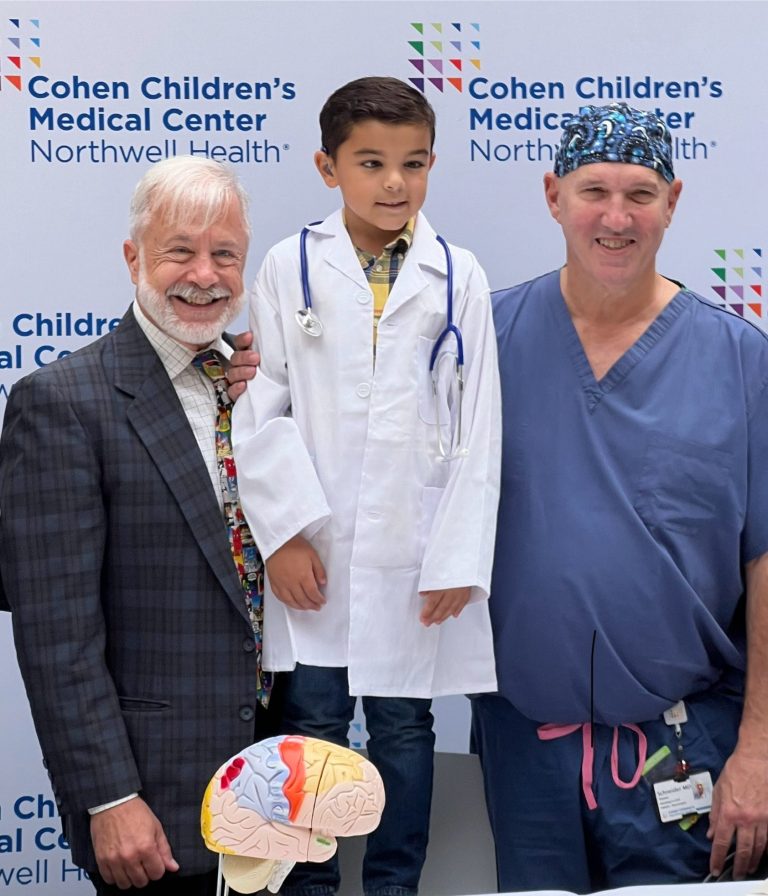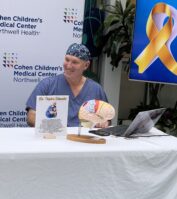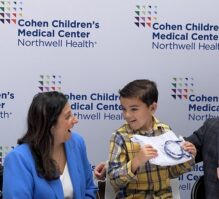
New Hyde Park doctors honor cancer survivor Joseph Baggio during Pediatric Cancer Awareness Month.
Joseph Baggio’s active life suddenly changed when he was 4 years old. His mother, Rose Baggio, said her son began to lose his balance and fall. After being unable to keep his balance, Joseph’s parents brought him to Cohen Children’s Medical Center in New Hyde Park on July 18, 2021.
“On his examination, he was very poorly coordinated,” Steven Schneider, co-chief of the Division of Pediatric Neurosurgery at Cohen, said. “He was very unsteady as he was walking and crossing his eyes—all signs of what we call increased pressure on the brain.”
A brain MRI revealed that Joseph had a large brain tumor in the posterior fossa, near the cerebellum, that is largely responsible for balance. The diagnosis of the tumor was a medulloblastoma, which is the most aggressive, grade 4 brain cancer among young children.
Schneider placed a tube in Joseph’s brain to alleviate the pressure. He then removed the tumor in a six-hour operation, and none of the cancer had spread to the rest of his body.
Medulloblastoma has a relatively high cure rate with the standard therapy of both chemotherapy and radiation to the whole brain and spine. However, the use of the necessary dose to the whole brain in children as young as Joseph can cause severe cognitive disability. Therefore, Joseph was offered the opportunity to enroll in the Head Start 4 study, which is a national study geared towards radiation-free therapy for children with localized medulloblastomas.
His family agreed to have him participate in the study.
The study is a randomized clinical trial hosted and coordinated by Nationwide Children’s Next Consortium. Its goals are to determine if the treatment in the protocol will improve the quality of survival and cure rates for young children ages 10 or under who are newly diagnosed with the most common types of malignant brain tumors in childhood.
The treatment involves testing two strategies. First, reducing the number of initial chemotherapy cycles from five to three for kids who respond well after three chemotherapy cycles to determine whether doctors can sustain high survival rates and quality of life in patients.
The second strategy is randomizing high-risk children — those unable to respond well after initial chemotherapy — to either a single cycle or three cycles of high-dose chemotherapy with blood cell rescue. This strategy seeks to determine if the outcome for these higher-risk children can be improved by intensifying treatment with the three transplant cycles of chemotherapy.
It was recommended that Joseph receive three rescue transplants and a total of six admissions of chemotherapy — three for regular chemotherapy and three for high-dose chemotherapy.
“During this he needed physical therapy, occupational therapy, speech therapy to get strong again,” Dr. Mark Atlas, director of the Childhood Brain and Spinal Cord Tumor Program at Cohen Children’s, said.
Atlas said Joseph developed hearing loss in both ears, which was a long-term side effect of the chemotherapy. Joseph was also diagnosed with posterior fossa syndrome, as his speech was severely affected, along with the motor ability in his arms. However, Atlas said Joseph has been doing well, and “his outlook is very promising.”
“We understand that a cancer diagnosis in a young child affects not only the patient, but the entire family, the neighborhood and the community,” Schneider said. “They say it takes a village to raise a child, but in the case of pediatric cancer, it takes a whole city.”
Joseph and his family presented Schneider with an original piece of artwork created for him. In return, Schneider gifted Joseph with a soccer ball, a white doctor’s coat and a stethoscope.


Now officially in remission, Joseph is back in school and playing soccer and baseball. He told his mother he plans to be a neurosurgeon when he grows up, just like Schneider, because he also wants to be “very smart and save children’s lives.”






